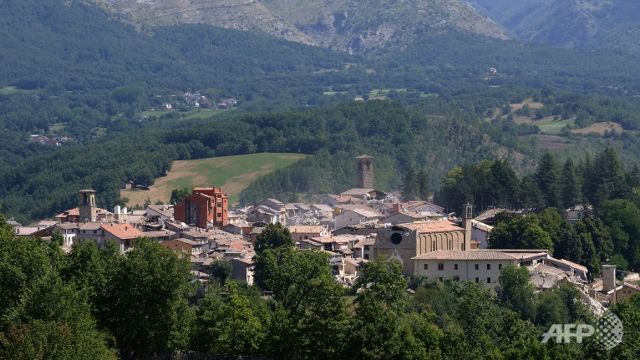Italian cooks take to the stoves for quake victims
 |
| General view of the damaged central Italian village of Amatrice, a day after a 6.2-magnitude earthquake struck the region. (AFP/Filippo Monteforte) |
Chefs around the world are being urged to follow suit after the Slow Food movement threw its weight behind the idea.
Amatrice was one of several mountain villages devastated by Wednesday's powerful quake and it will be some time before the hilltop beauty spot is once again serving up its signature dish to the gastronomic pilgrims who flock there in their thousands every summer.
In the meantime, amatriciana, one of the staples of the cuisine of Rome and much of central Italy, is going to be much more widely available thanks to Paolo Campana, a graphic artist from the Italian capital.
Under an initiative he launched on Facebook, restaurants are being encouraged to put amatriciana on their menus and to donate two euros from every dish sold to the relief fund for the quake victims.
The idea has taken off spectacularly with over 700 restaurants having contacted him by Thursday lunchtime to say they wanted to participate, he told AFP.
"I'm very attached to Amatrice," he said. "On New Year's eve last year I had dinner in the Hotel Roma which makes the best amatriciana in the village. Today there is nothing of it left."
The hotel Campana was referring to collapsed in Wednesday's quake, just days before it was due to be at the centre of an annual festival dedicated to a sauce first created by shepherds in the rugged mountains that surround the village.
"At the start it was just a rough idea I put up on Facebook. But it has taken off and I've made a little poster that restaurants can put up in their windows to show they are participating in the initiative.
CULINARY CONFUSION
"I've got requests from all over Italy, from Puglia to Tuscany, and also from abroad. I have been asked to translate the sign into several languages to export the scheme. Even restaurateurs who have never cooked amatriciana before are going to have a go."
Carlo Petrini, president of the Slow Food movement, urged restaurants around the world to put the dish on their menus for at least a year.
"We hope in this way to keep the public's attention for longer - we have to look beyond the immediate emergency and start working from today to rebuild," he said.
Amatriciana is one of those dishes that Italians love to argue about.
Although it is always essentially a combination of pork cheek (guanciale), onions, tomatoes and pecorino cheese spiced with a bit of chilli, recipes vary significantly, particularly as the dish has been exported around the world.
Some people use sweet-cured pancetta (pork belly) instead of guanciale, others, including the celebrated River Cafe restaurant in London, throw in a bit of rosemary.
Spaghetti is the most frequently used pasta but in Rome, where the restaurant trade is full of natives of the Amatrice region, they favour bucatini, a slightly thicker noodle with a hole in the middle.
There is also debate over whether to use red or white wine to deglaze the pan after frying the cured pork and onions to the (also much discussed) correct degree of caramelised crispness.
Against this backdrop of culinary confusion, the local council in Amatrice issued a decree a few years ago spelling out exactly how to make an authentic amatriciana.
Spaghetti gets the nod as the pasta of choice, no more than a splash of white wine is allowed and if you use anything other than fatty guanciale you must give your sauce another name.
"Only with guanciale will the dish be incomparably delicate and sweet," the council warns on its website.
San Marzano tomatoes, peeled, seeded and diced, are de rigeur.
A tiny piece of fiery dried chilli is all that is required for a subtle heat and the grated pecorino must only be added at the end, to the cooked spaghetti just before the sauce.
What the stars mean:
★ Poor ★ ★ Promising ★★★ Good ★★★★ Very good ★★★★★ Exceptional
Latest News
More News
- 72 nations sign landmark Hanoi cybercrime convention (October 26, 2025 | 18:00)
- UN Secretary-General commends Vietnam’s global leadership (October 26, 2025 | 09:00)
- APEC finance ministers convene to tackle regional challenges (October 22, 2025 | 17:31)
- Rewiring global trade: ASEAN’s rise as supply chain hub (October 17, 2025 | 11:40)
- Vietnam attends first World Nuclear Week Forum in Russia (September 26, 2025 | 10:50)
- Vietnam attends 69th session of IAEA General Conference (September 16, 2025 | 10:00)
- ADB, WB pledge over 12 billion USD for ASEAN power grid, renewable energy projects (August 15, 2025 | 14:18)
- Lowy Institute proposes AI-based tobacco control solutions for ASEAN (August 15, 2025 | 14:14)
- Cloud computing policy to position Malaysia as regional hub by 2030 (August 15, 2025 | 14:11)
- Thailand, Cambodia suffer numerous cyber attacks (August 05, 2025 | 16:19)

















 Mobile Version
Mobile Version